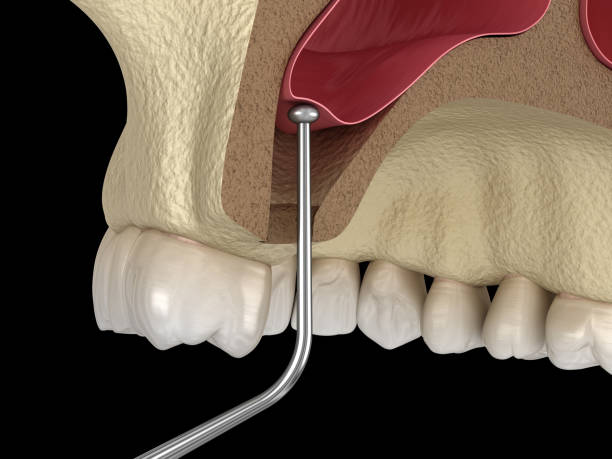Wisdom Tooth Removal Cost UK. A Complete Guide Wisdom teeth are the last molars to appear in the mouth, usually developing between …
Sinus Lift Procedure: A Key Step for Successful Dental Implants
A sinus lift procedure, also referred to as sinus lift surgery, is a dental operation aimed at enhancing the bone lining the sinus cavities to prepare for implant placement. This is used when a patient has inadequate bone height needed for successful implantation.

What are your sinuses and why are they important in sinus lift surgery?
Your sinuses are important structures located in the bones of your face and around the nose. They are cavities filled with air that connect to your nasal passage. Sinuses have several functions but they can generally be likened to parts of a sophisticated air conditioning system within your head, designed to filter, humidify, and regulate the air you breathe. Your sinuses are lined with a moist membrane that produces mucous to help trap dust, particles and bugs from the air, and heat up cold air before it enters the lungs.
There are four main sinuses in the skull
Maxillary sinuses: Large, balloon shaped air-spaces behind the cheekbones
Frontal sinuses: Two small air spaces above the eyebrows
Ethmoid sinuses: Honeycomb like airspaces between the eyes and behind the nasal bridge
Sphenoid sinuses: Located deep in the skull
Nasal sinuses: located around the nose
The sinuses important in the context of dental implants are your maxillary sinuses, located behind the cheekbones and above the upper molars and premolars in the jawbone. Augmentation of the maxillary sinuses has become popular in the world of dentistry since the creation of the CBCT scanner which has allowed dentists to properly visualise the structures surrounding the molars.
Why might someone need sinus lift surgery?
There are various reasons why a patient may need sinus grafting prior to their implants. These include:
Inadequate bone height: there is not enough bone in your upper jaw to support any implants. This is usually determined by a bone height of <8mm, picked up on the CBCT scanner
Natural bone loss – bone loss due to periodontal diseases, tooth decay or tooth loss. This may lead to weakening of the bones above the molars and cause bone degeneration, making the bone unsuitable for implantation.
Sinus size and position: some people have large maxillary sinuses. Imagine these like big hollow spaces behind your cheeks. If the spaces are too large, there is less room for bone!
What is the sinus lift surgery?
There are typically 4 core stages to any sinus graft procedure: initial assessment, the sinus lift, the healing phase and implant placement. We will talk through each of these in turn.
Assessment
Your dentist should conduct a thorough assessment and examination. This should include using CBCT scans to evaluate the anatomy of your sinuses and define the degree of bone loss. Properly establishing the anatomy of your sinuses can help reduce the risk of intraoperative and postoperative complications
The surgical procedure
Anaesthesia: before the procedure begins, you will typically be given some local anaesthetic injected into your gum. This will cause the area surrounding the site to go numb. Some dentists may offer oral or IV sedation techniques, which can help you relax and help combat dental phobia.
Accessing the sinus: A small surgical incision will be made in your gums, exposing the jawbone beneath.
Lifting the sinus membrane: this is the mucous membrane that lines the sinuses. Your dentist will gently push this upwards, creating a small space between the sinus and your jaw.
Bone Graft Placement: bone graft material is now placed into this compartment. The specific material used can vary from dentist to dentist, but it will act as a scaffold to facilitate bone formation.
Healing period
Once the bone graft material has been placed, your dentist will close the incision in the jawbone. Across the next few months, this bone material will integrate into the existing bone structure in a process known as osseointegration. This will ensure the bone is strong enough to hold the dental implant.
Implant placement
Finally! With your newly placed bone in the maxillary sinus, your dentist will now place an implant in this scaffolding.
What to expect after sinus lift surgery?
Recovery: Immediately after the surgery, and for the next week or so, you may have some lasting pain and swelling. The healing process may depend on the type of graft used, but you should use pain relief and ice in the short term to manage any discomfort.
Follow up: As with most dental procedures, expect your dentist to recommend robust follow up visits to monitor your healing and help plan for the implant procedure.
Potential complications of sinus lift surgery
During surgery
There are some complications that may happen during the sinus graft procedure. These can be minimised by thorough pre-operative planning and by visiting dentists with plenty of experience with sinus grafting.
Complications during surgery can include bleeding, penetration into the sinus cavity, damage to adjacent teeth, incorrect placement of the bone or implant, and bone fractures.
After surgery
After surgery, you should expect some discomfort which can be managed by adequate pain relief and ice. There is also a risk of infection, bleeding and bruising in the acute period post-surgery.
How can The Harley Street Implant Centre help?
If you are considering implants in your upper jaw (below your maxillary sinus), talk to your dental surgeon about whether a sinus graft is for you. This discussion will likely take place after a CBCT scan and detailed assessment from your dentist.
Sinus graft surgery is a specialist procedure that augments the bone in your jaw and is used whenever patients have reduced bone in height in the upper jaw. Following the procedure, a dental implant can be placed in a new, sturdy foundation. This blog outlined the process of sinus grafting and its benefits and risks to help you make an informed decision about your health.
IV Sedation Myths : 3 Of The Most Common Myths Debunked
For many patients, the most difficult part of getting dental implants is not the surgery itself but making the decision to seek …
Non Surgical Wisdom Tooth Extraction Recovery
Non Surgical Wisdom Tooth Extraction Recovery: A Harley Street Guide Recovering from a non-surgical wisdom tooth extraction is usually straightforward, but knowing …
Why We Built a High-End Dental Implant Clinic from Day One, And Why It Matters for Your Care
When people hear that we built a high end dental implant clinic on Harley Street, the first question they often ask is …



